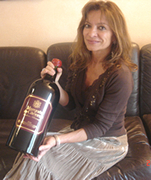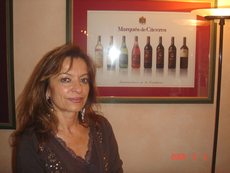|  We were received at the steps of a beautiful building that looked like an office block by an elegantly attired lady who turned out to be Cristina Forner, CEO of Marques de Caceres- a winery with links to the old traditions, yet very modern in its winemaking techniques. A new Rioja, really. Sitting next to her at the head table I was able to chat with her at length about her wine ry and the wine s which are extremely popular in the USA . They are also being imported into India by Sula. We were received at the steps of a beautiful building that looked like an office block by an elegantly attired lady who turned out to be Cristina Forner, CEO of Marques de Caceres- a winery with links to the old traditions, yet very modern in its winemaking techniques. A new Rioja, really. Sitting next to her at the head table I was able to chat with her at length about her wine ry and the wine s which are extremely popular in the USA . They are also being imported into India by Sula.
My father, Enrique Forner left Spain in 1936 because of the Fascist regime of Franco. Carrying the family legacy of wine merchandising, he moved to Rhone, Loire Valley and finally in Bordeaux where he bought Ch. Camnesac, a Grand Cru Classe` property and Ch. Larose Trintaudon, a Cru Bourgeois Supe`rieur. He decided to move back to Spain in 1970 and start producing wine.
As you know, it is not easy to own property in Rioja as there are very small parcels of land owned by the growers for generations and they don't like to part with the property. So he decided to work closely with vineyards. 'We have contracted long term contracts with the local growers...
Prices of Riojan wine s have been going northwards resulting in people moving away from Rioja. Our journalist friend Jorgesson from Copenhagen tells me that before Spain and Denmark joined the EU, at one time Denmark used to import mostly Spanish wine s, 80% of which were from Rioja. Due to the continuous price hike, they reduced their import to a trickle in 2000. Now the sales are getting back up but only after the prices came down. 'Don't you think Rioja killed the goose that lay the proverbial golden egg?' I enquired. 'I agree with you fully,' she said. 'At Marque`s de Ca`ceros our philosophy has been consistent and different from others. We believe in making the best possible product and offer it at reasonable prices to ensure our steady growth. We have had no problems with our sales,' she added
What were the technological improvements her wine ry made to produce wine s better than the classical wine s of Rioja? 'We installed the best possible equipment for proper vinification and aging of wine s. We also reduced the time spent in barrel aging as was the practice in Rioja 30-40 years ago. We also discarded the common practice of continuous use of old barrels that left the tastes and aromas of previous wine s. Instead, we started to renovate the casks on a regular basis to obtain full potential of the wine with better balance of oak and fruit', she explained.
'We also select the finest of French oak barrels to achieve a subtle, delicate vanilla touch that complements the fruit, especially for our wine s that age for longer periods like Reservas and Gran Reservas, We have more than 40,000 barrels with half of them being French, the other half are America oak'
This comment of hers made me ask her what I had been meaning to ask several other producers. 'The impression I have through tastings at Los Grandes de La Rioja is that many producers oak their wine s for too large a period, especially the Gran Reservas. This gives too much oak in the flavour and the fruit dies down.' Before answering me she called a waitress and whispered something to her in Spanish. A couple of minutes later a couple of bottles of 1998 Gran Reserva arrived at the head table. They were not in the Menu. ' I would like us to taste these wine s. We are using new Oak barrels and leave in the barriques for just the right time to get the vanilla flavours and soften the tannins without losing freshness. You will always find enough fruit and yet complexity in our wine s.
How much of wine s do you export?
We have been exporting since 1975 and 50% of our sales are exported to 80 countries. We are a leading brand of Spanish Wines in the USA .
What about India ? You have been exporting to India through Sula for a couple of years.
We are very excited and interested in the Indian market. We feel there is a great market for our products there because of the excellent price-quality equation we have. We hope we can increase our market share in India in future.
 Cristina Forner, mother of a 10-year old daughter represents the future of the Bodega. Her sister is married and lives in the US . Her brother lives in Madrid and though helps the company with sales, she remains the heir apparent. She lives in Logronyo with her daughter who takes interest in her activities and is fairly knowledgable about wine s produced by her family. She is not allowed to drink her wine s though. 'When she is the right age, perhaps she can have a glass or two and I hope she grows up to love wine and not other hard liquor that young kids get into these days,' she worries. Cristina Forner, mother of a 10-year old daughter represents the future of the Bodega. Her sister is married and lives in the US . Her brother lives in Madrid and though helps the company with sales, she remains the heir apparent. She lives in Logronyo with her daughter who takes interest in her activities and is fairly knowledgable about wine s produced by her family. She is not allowed to drink her wine s though. 'When she is the right age, perhaps she can have a glass or two and I hope she grows up to love wine and not other hard liquor that young kids get into these days,' she worries.
Her father is the President and she is the CEO. 'When it comes to taking major decisions do you take them by yourself or are you your father's daughter first and seek his advice?' I asked. 'Oh, I am my father's daughter first,' was her spontaneous response. 'We sit down and discuss. Only then the decision is taken.
Prince Bernard of Holland is very fond of Spanish wine s, especially ur wines.
Paco Rabanne describes MC as John Galiano with his talent and passion; the Reservas and Gran Reservas are more like Yves-Saint-Laurent, very fine and subtle. Gaudum is more comparable to Christian Lacroix, haute Couture with a controlled exuberance. Well, In India YSL commands respect and is affordable too. So bring on the Reservas and Gran Reservas, Cristina!
'Wine means everything to us,' is her philosophy and that of Marques de Caceres. We couldn't agree more; it is the same for us too at the Delhi Wine Club and Indian Wine Academy .
RANGE OF WINES |